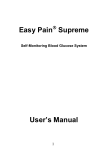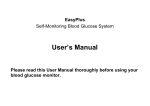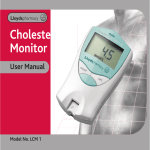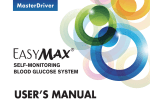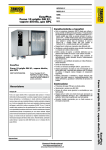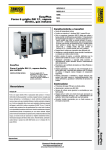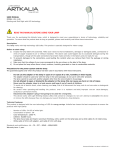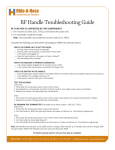Download User`s Manual - EPS Bio Technology Corp.
Transcript
EasyPlus mini R2N Self-Monitoring Blood Glucose System User’s Manual Please read this User’s Manual thoroughly before using your blood glucose meter. Dear EasyPlus mini R2N SMBG System Owner, Thank you for using the EasyPlus mini R2N Self-Monitoring Blood Glucose (SMBG) System. We designed this system to be dependable, easy-to-use, compact, lightweight and portable to help you monitor your blood glucose on a regular basis. Please read this manual thoroughly before you begin testing. This manual provides you and your diabetes care team with important information and step-by-step direction to use the EasyPlus mini R2N Self-Monitoring Blood Glucose System. To start testing quickly, you can also refer to the Quick Reference Guide. Thanks again for choosing the EasyPlus mini R2N SMBG. Intended Use The EasyPlus mini R2N Self Monitoring Blood Glucose Test System is intended for the quantitative measurement of glucose in fresh capillary whole blood samples drawn from the fingertips or forearm. Testing is done outside the body (In Vitro diagnostic use). It is indicated for use at home (over the counter [OTC]) by persons with diabetes, or in clinical settings by healthcare professionals, as an aid to monitor the effectiveness of diabetes control. Standard Accessories Your new EasyPlus mini R2N Blood Glucose meter and accessories work together to measure the amount of glucose in your blood. The system includes: • Wallet • User’s Manual • Self-Test Log Book • Warranty Card • EasyPlus mini R2N Blood Glucose Meter • Test Strip Instructions • Lancing device • EasyPlus mini R2N Blood Glucose Test Strips (10 pcs) • Glucose Control Solution Instructions • Check Strip • Quick Reference Guide • CR2032 Lithium Cell 3V Battery (2 pcs) • Lancets (10 pcs) • EasyPlus mini Glucose Normal Control Solution • EasyPlus mini Glucose High Control Solution Why is it so important to test blood glucose regularly? Testing your blood glucose regularly can make a big difference in how you manage your diabetes every day. We’ve made this SMBG system as simple as possible to help you use it regularly. Your meter is easy to use, and you can adjust the lancing device for your comfort. Do you need Help? If you have questions or need assistance, please call the Customer Care Service toll-free at 1-866-203-2761(Eastern Time, Mon-Fri 9:00AM~5:00PM). You can also visit www.epsbio.com.tw for diabetes management tools and product demonstrations. Please complete your warranty card and mail it, so you receive the best customer service possible and news about product update. Note: Although the EasyPlus mini R2N SMBG System is easy to use, you may need to consult with your healthcare professional (this may be your doctor, pharmacist or diabetes nurse educator) for instructions on how to use the system. Only the correct use of the system will ensure accurate results. Important Information About Your New Meter EasyPlus mini R2N blood glucose meter is designed and approved for testing fresh capillary whole blood samples from your fingertip and forearm. The meter is for in vitro diagnostic use ONLY(for testing outside the body). It should not be used to diagnose diabetes. EasyPlus mini R2N blood glucose meter can only be used with EasyPlus mini R2N Blood Glucose Test Strips. Other test strips will give inaccurate results. Testing is not valid for neonatal blood specimens. Do not disassemble the meter as this may cause damage to the components resulting in incorrect readings. Disassembling the meter will also void the warranty. Always keep the meter clean and store it in a safe place. Protect the meter from direct sunlight to ensure a longer lifespan. You should not store the meter and test strips in a car, bathroom, or refrigerator. Keep the meter, test strips and lancing device away from children and pets. You should not test critically ill patients with home-use blood glucose meters. Incorrect results may occur when performing the test. If you believe you are not feeling well, please contact your healthcare professional. Remove batteries if the meter will not be used for one month or more. Warning for potential biohazard: Healthcare professionals using this system on multiple patients should be aware that all products or objects that come in contact with human blood, even after cleaning, should be handled as if capable of transmitting a viral disease. Consult with your healthcare professional before testing on your forearm. Do not touch the strips with wet hands. Do not use expired strips (the expiration date is shown on the bottle.) Do not bend, cut or twist the strips. Altitude up to 10,000 feet above sea level has no effect on readings. Health-Related Information If you are experiencing dehydration, frequent urination, low blood pressure, shock or hyperosmolar hyperglycemic nonketotic coma (HHNK), you may get a test result that is lower than what your blood glucose really is. If you think you are dehydrated, call your doctor right away. If you have followed the steps in the user’s manual, but still have symptoms that don’t seem to match your test results, or if you have questions, please talk to your doctor or health care professional. Please read your test strip instruction carefully for additional health-related information. Warning for potential biohazard: Healthcare professionals using this system on multiple patients should handle all products or objects in contact with human blood carefully to avoid transmitting viral disease, even after cleaning. Table of Content Chapter 1: Understanding Your Meter ….......................................................................................................10 The EasyPlus mini R2N Blood Glucose Meter …......................................................................................10 Setting The Time And Date ........................................................................................................................12 Setting Hypo And Hyper ........................................................................................................................13 Checking Your Meter …...........................................................................................................................14 Using EasyPlus mini R2N Blood Glucose Test Strips ...............................................................................15 Chapter 2: Control Solution Test ...................................................................................................................16 Why Run A Control Solution Test ............................................................................................................16 About The Control Solutions ......................................................................................................................17 Running A Control Solution Test ................................................................................................................18 Understanding Control Test Results …......................................................................................................20 Chapter 3: Testing Your Blood Glucose .......................................................................................................22 Using The Lancing Device .........................................................................................................................22 Inserting A Lancet into the Lancing Device ................................................................................................23 Running A Blood Glucose Test With Blood From Your Fingertip ..............................................................25 Alternative Site Testing ……...…………………………………………………………………………………….27 Running A Blood Glucose Test With Blood From Your Forearm ...............................................................29 Discarding Used Lancets ….......................................................................................................................30 Expected Values ….............................................................................................................................31 Unusual Test Results …………………………….......................................…………………………………...31 Symptoms Of High Or Low Blood Glucose …................. ..........................................................................32 Comparing Your Meter Result To Lab Results ….....................................................................................33 Chapter 4: Meter Memory, Setup …...............................................................................................................34 Memory, Storing Test Results …................................................................................................................34 Viewing Test Results …............................................................................................................35 Setting The Alarm …...................................................................................................................................36 Chapter 5: Maintenance And Troubleshooting ….........................................................................................37 Installing Batteries …..................................................................................................................................37 Cleaning Your Meter ……...........................................................................................................................38 Maintenance And Testing ..........................................................................................................................39 Cleaning Your Lancing Device …...............................................................................................................39 Screen Messages And Troubleshooting …................................................................................................40 Chapter 6: Technical Information …..............................................................................................................42 Specifications ….........................................................................................................................................42 Limitations…...............................................................................................................................................43 Device Information ….................................................................................................................................45 Warranty ....................................................................................................................................................45 Chapter 1: Understanding Your Meter The EasyPlus mini R2N Blood Glucose Meter The Overview of the Display month and date Time Test result Error Application of blood or E Control Solution A B C D F Control solution test G Hypo H Hype I Test records J Insert test strip K Glucose unit L Thermometer M Batteries status Meaning Show the moment of month and date. Show the moment of time. Show the test result. The meter system is in fault. Test your level of blood glucose. Control Solution test, whose value won’t be included in the testing memory. Set your hypo value. When test result is under the setting value, meter will alarm you. Set your hype value. When test result is over the setting value, meter will alarm you. The meter will memory automatically all of test results. Insert the test strips to start testing blood glucose. The testing unit of blood glucose in USA is mg/dL. The thermometer icon appears, when the temperature is too high or too low. When the battery symbol appears, prepare other batteries for installation. 10 The Overview of the Meter: A. Anti-Slippery Ring B. Battery cover C. Display D. Manufacturer information E. Serial number F. Strip slot The Overview of the Test Strip: A. Blood collection area B. Reaction area C. Holding area D. Strip insert direction E. Electrode 11 Setting The Time and Date—First Time Use Setting the current time and date in your meter is important if you use the meter memory. 1. Press “W ”until turning the meter on. Press “W ” once again and release to enter the setting mode. 2. The last 2-digits of the year flash at the center of the display. Press “X ” to adjust the year and Press “W ” to confirm the setting. 3. Repeat step 2 to set the date and time. The flashing field is the one you are currently setting. 12 Setting Hypo and Hype 4. Press “X ” to adjust value of hypo and Press “W ” to confirm the setting. 5. Press “X ” to adjust value of hype and Press “W ” to confirm the setting. 6. When setting is finished, the display will be back to the testing mode of flashing strip. Note: Hypo setting are from 60 mg/dL to 80 mg/dL; Hype setting from 150 mg/dL to 600 mg/dL. 13 Checking Your Meter A new check strip is included with your meter. The check strip tests only the function of the meter and not the test strip’s ability to render a result (which would need a control solution), or the accuracy of the system as a whole. 1. Make sure your check strip is inserted. The meter will turn on automatically. 2. The screen displays "OK". Note: 3. Remove the check strip and the meter will turn off automatically. Store the check strip in a safe place. When the display shows “FAL”, re-insert the check strip. If FAL appears again, please call our Toll-Free number 1-866-203-2761. 14 Using EasyPlus mini R2N Blood Glucose Test Strip Use only with EasyPlus mini R2N Blood Glucose Meter. Keep the test strips in their original bottle. Close the bottle tightly right away, after you take a test strip out. This keeps the test strips dry. Use the test strip within three minutes after taking it out of the bottle. The strip is for single use only. Do not reuse it. Record the date you open the test strip bottle. Be sure to check the expiration date on the test strip bottle. The test strip is good for three months from the date the bottle is opened or until the expiration date on the bottle, whichever comes first. Store the test strip bottle and your meter in a cool dry place. Store the test strips between 35.6°F ~86°F (2°C ~30°C). Do not freeze. Do not apply blood or control solutions to the test strip before you insert it into the meter. Do not touch the test strip with wet hands. Do not bend, cut, or twist the test strips. 15 Chapter 2: Control Solution Testing Why Run A Control Solution Test We recommend that you run the EasyPlus mini R2N Normal and High Control Solutions. Such test will let you know that your meter and test strips are working properly to give reliable results. You should run the control solution tests when: You use the EasyPlus mini R2N Blood Glucose Meter for the first time. You open a new bottle of test strips. You think the meter or test strips may be working incorrectly. You drop the meter. You have repeated a test and the test results are still lower or higher than expected. You are practicing the test procedure. Note: Professional users are instructed to follow federal, state, and local guidelines. 16 About The Control Solutions Use only with EasyPlus mini R2N test strips. Write the date you opened the bottle on the bottle label. The control solutions are good for three months from the date the bottle is opened or until the expiration date on the bottle, whichever comes first. Do not uses control solutions that are past the expiration date. The control solutions can stain clothing. If you spill them, wash your clothes with soap and water. Close the bottle tightly after every use. Left over control solutions should not be added back into the control bottle. Store the bottles of control solutions at room temperature, between 35.6°F ~86°F (2°C~30°C). Do not freeze. If you would like to purchase EasyPlus mini R2N Normal and High Control Solutions, please contact your local dealer or call Customer Service toll-free 1-866-203-2761. 17 Running A Control Solution Test 1. Put a test strip into the meter in the direction of the arrow. 2. Press “X” for 1 seconds to 5. Squeeze the bottle until a tiny drop forms at the tip of the bottle. set “ ”. Touch the drop to the Blood collection area at 3. Place the meter on a flat surface, like a table. the end of the test strip. 4. Remove the control Do not put control solution on top of the solution bottle cap and test strip. wipe the tip of the bottle When you hear the beeper, you have enough with a tissue. control solution in the test strip. The meter starts to count down from 5 seconds and will show the results. 18 6. A result appears on the display. Don’t remove the test strip yet. Check if the reading falls within the range printed on the test strip bottle. 7. Remove the test strip and throw it away after you have compared the reading to the range printed on the test strip bottle. 19 Understanding Control Test Results The label on your test strip bottle shows the acceptable ranges for the Control Solutions. The result you get should be inside this range. Make sure you compare the result to the correct level of control. When the control result is inside the range on the test strip bottle, your test strips and your meter is working properly. If your control result is not inside the acceptable range (printed on your test strip bottle), here are some things you can do to solve the problem: Note: Control Solution values will be included in the memory and averages, if a flag icon of “ set. ” is NOT 20 Troubleshooting Checks Action 9 Was the test strip exposed to open air for a long period of time? Repeat the control test with properly stored strips. 9 Was the test strip bottle capped tightly? This will humidify strips inside. Replace the test strips. 9 Was the meter functioning well? You can use the check strip to verify the meter’s functions. 9 Are the control solutions expired or contaminated? Replace with a new control solution to check the performance of SMBG system. 9 Were test strips and control solutions stored in cool, dry places? Repeat the control test with properly stored strips or control solutions. Read Chapter 2 "Control Solution Testing" and test again. Stop using the meter if you continue to obtain the inaccurate results. Call Consumer Services Toll-Free: 1-866-203-2761(Eastern Time, Mon-Fri 9:00AM~5:00PM). 9 Did you follow the testing steps properly? 21 Chapter 3: Testing Your Blood Glucose Using The Lancing Device The best depth setting is the lowest number that draws enough blood for a test. Try different settings to find the one that’s right for you. Please do not share your lancing device with anyone. And always use a new, sterile lancet. Lancets are for one time use only. Note: Used test strips and lancets are considered bio-hazardous waste in accordance with U.S. local regulations and should be handled as if capable of transmitting infection. The users may discuss methods for disposing used test strips and lancets with their doctor. 22 Inserting A Lancet Into The Lancing Device You must first load the lancet into the lancing device to get it ready for use. 1. Take the cap off. 2. Insert the lancet into the lancing device firmly then twist off the protective cover. 3. Recap the front cap. 23 4. Select the desired penetration depth. 5. Pull on the sliding barrel of the lancing device until it clicks and then release. Now the lancing device is ready. Do not prick your finger until your meter and strip are prepared. 6. Set the lancing device aside until later in the test. Note: Select 1-3 for soft or thin skin, 4-5 for average, and 6-8 for thick or calloused skin. 24 Running A Blood Glucose Test With Blood From Your Fingertip 1. Wash your hands with soap and warm water. Rinse and dry thoroughly. 2. Put a test strip into the meter in the direction of the arrow. The meter turns on. Note: If a flag icon of “ ” is set, press “X” for 1 seconds to cancel the setting of control solution test. 3. Swab the blood collection area on your finger with an alcohol swab. Please wait at least 5 seconds until the intended area is dry and clean before sampling the blood. 4. Place the lancing device against the pad of your finger. Press the trigger button to activate the lancing device. 25 5. When the blood drop flashes on the display, obtain a drop of blood from your fingertip. 6. Gently squeeze your finger to assist the flow of blood. This helps you get a blood drop. Touch the drop to the tip of the transparent window of the test strip. Do not put blood on top of the strip. Be sure to get enough blood on the strip’s reaction zone. Otherwise, an inaccurate reading may result. 7. The meter will beep when enough blood has entered the strip’s reaction zone. The result will appear on the display after 5 seconds. 26 Alternative Site Testing (AST) Understanding Alternative Site Testing What is AST? Besides the fingertip, you can test the forearm. What is the advantage of AST? You have the option of testing other places on your body besides the fingertip. Consult your health care professional before you begin using the forearm for testing. Blood glucose test results obtained from your forearm may differ significantly from fingertip samples. We strongly recommend that you: Do AST ONLY in the following intervals: In a pre-meal or fasting state (more than 2 hours since the last meal). Two hours or more after taking insulin. Two hours or more after exercise. Do NOT use AST if: you think your blood glucose is low. you are unaware of hypoglycemia. your AST results do not match the way you feel. you are testing for hyperglycemia. your routine glucose results are often fluctuating. If you are pregnant. 27 Fingertip test only: If sick If blood glucose is low After exercising Two hours or less after eating When basal insulin is most active After injecting rapid-acting insulin (two hours or less) What NOT to do: If the blood glucose test result does not match how you feel, do a fingertip test to confirm the result again. Do NOT change your treatment just because of an alternate site result, do a fingertip test to confirm the result. If you often do not notice when your blood glucose is low, do a fingertip test. Caution: Talk with your healthcare professional before you test forearm. Do NOT ignore symptoms of high or low blood glucose. Fingertip samples are able to show the rapid change of glucose faster than forearm samples. 28 Running A Blood Glucose Test With Blood From Your Forearm 1. Massage the puncture area of forearm for a few seconds. 2. Change the gray cap into limpid cap for AST testing. 3. Press and hold the device with one clear adjustable tip against the forearm. 4. Press the trigger button to activate the lancing device. Hold the device against forearm and increase pressure until the blood sample size is sufficient 29 Discarding Used Lancets 1. Take the adjustable cap off. Without touching the used lancet, stick the lancet tip into its protective cover. Grip the lancet carrier firmly and pull the lancet safely out. 2. Discard the used disposable lancet into a container for sharp or biohazard material. 30 Expected Values The EasyPlus mini R2N Blood Glucose test strips are whole-blood referenced and calibrated for easier comparison to lab results. The normal fasting blood glucose range for an adult without diabetes is 70~110 mg/dL. Two hours after meals, the blood glucose range for an adult without diabetes is less than 120 mg/dL. For people with diabetes: please consult your doctor for the blood glucose range appropriate for you. Unusual Test Results If your test result doesn’t match the way you feel, please follow these steps: 1. Run a control test, Chapter 2, "Control Solution Testing." 2. Repeat a blood glucose test, Chapter 3, "Testing Your Blood glucose." 3. If your test results still don’t reflect the way you feel, call your doctor immediately. Note: 1. Extremely high humidity may affect the test results. A relative humidity greater than 90% may cause inaccurate results. 2. Hematocrit below 20% may cause higher results. Hematocrit above 60% may cause lower results. 3. Some studies have shown that electromagnetic fields may affect results. Do not test near an operating microwave oven. 31 Symptoms Of High Or Low Blood Glucose Being aware of the symptoms of high or low blood glucose can help you understand your test results and decide what to do if they seem unusual. Here are the most common symptoms: 1 Below 60 mg/dL 2 Greater than 240 mg/dL What It Means: The test result is higher than reference range. (70~110mg/dL) What It Means: The test result is lower than reference range. (70~110mg/dL) Symptoms: fatigue, increased appetite or thirst, frequent urination, blurred vision, headache, general aching, or vomiting. Symptoms: sweating, trembling, blurred vision, rapid heartbeat, tingling, or numbness around mouth or fingertips. What to Do: If you are experiencing any of these symptoms, test your blood glucose. If the result displayed is greater than 240 mg/dL and you have symptoms of high blood glucose, contact your healthcare professional instantly. If the result does not match how you feel, follow the steps under "Unusual Test Results." What to Do: If you are experiencing any of these symptoms, test your blood glucose. If the result displayed is below 60 mg/dL and you have symptoms of low blood glucose, contact your healthcare professional instantly. If the result does not match how you feel, follow the steps under "Unusual Test Results." 32 Comparing Your Meter Result To A Lab Result The meter is equivalent to whole blood (as noted on the page 31 of the user’s manual). A common question is how the blood glucose results on your meter compare to the lab results. Your blood glucose can change quickly, especially after eating, taking medication, or exercising. If you test yourself in the morning, then go to the doctor’s office for a blood glucose test. The results will probably not match, even if you are fasting. This is typically not a problem with your meter, it just means that time has elapsed and your blood glucose has changed. If you want to compare your meter result to the lab result, you must be fasting. Bring your meter to the doctor’s office, and test yourself by fingertip within five minutes of having blood drawn from your arm by a healthcare professional. Keep in mind that the lab could use different technology than EasyPlus mini R2N blood glucose meter, and that blood glucose meters for self testing generally read somewhat lower or higher than the lab result. For accuracy and precision data and for important information on limitations, see the instructions that come with your test strips. 33 Chapter 4: Meter Memory, Setup Memory, Storing Test Results Your meter stores a maximum of 480 test results with the time and date of the test. You can review them at any time. When the memory is full, the oldest result is dropped as the newest is added, so it is very important to have the correct time and date set in the meter. Note: 1. Do not change your therapy based on one individual result in memory. 2. The memory is not lost when you replace the battery. You do need to check that the time and date are still correct. See the section "Setting the time and date" in Chapter 1. 3. Once 480 results are in memory, adding a new result causes the oldest one to be deleted. 34 Viewing Test Results 1. Press “X” to view the last test result. 2. Press “W” to view the previous results in order from the latest to the earliest. 3. Press “X” once again to view averages of 7-day test result. 4. Press “W” to review averages of 14-day, 30-day and 90-day test results. 5. Press “X” to be back to the testing mode of flashing strip. 35 Setting The Alarm The meter can set up to 4 alarms, allowing you to control your test times according to your requirements. 1. Press “X” for 5 seconds and enter the setting mode of alarm. 2. Press “W” to set “On” for the first alarm. 3. Press “W” to adjust time and press ” X” to confirm the setting (24-hour clock). 4. Press “X” to confirm the first 5. Repeat step 1 to 4 to set other 3 alarm. If you don’t want to setting and then get into the turn on the alarm at all, turn second one. every alarm "OFF" at the upper left corner of the display. Press “X” to confirm the setting. 36 Chapter 5: Maintenance and Troubleshooting Installing Batteries The meter uses two batteries of CR2032 Lithium Cell 3V. Batteries will normally last for over 2000 tests. Other types of CR2032 Cell 3V batteries are also acceptable, yet the capacity of test times may differ. Install the batteries when you first use the meter or replace with new batteries when the "LP" message and the low battery symbol appear on the display. Low battery symbol Note: 1. The meter won’t delete earlier records after you replace batteries. 2. You should reset the time and date again after you replace the batteries. 3. CR2032 Cell 3V batteries are available in shops. You may take the old batteries with you for replacement. 4. Remove batteries when you will not be using the meter for one month or more. 37 Cleaning Your Meter Caring for your EasyPlus mini R2N SMBG system does not require special cleaning. Please keep the meter free of dirt, dust, bloodstain, and water stains. Follow these guidelines carefully to help you get the best performance possible: Do: Do Not: Make sure the meter is turned off. Get any moisture in the test strip slot. Gently wipe the meter’s surface with a soft cloth slightly dampened. Spray any cleaning solution directly onto the meter. Put the meter under water or liquid. Pour liquid into the meter. 38 Maintenance and Testing Your meter needs little or no maintenance with normal use. It automatically tests its own systems every time you turn it on and lets you know if something is wrong. (See "Screen Messages" and what to do about them.) To make sure the display is working properly, turn off the meter. Press and hold “W” or “X” to see the complete display. All the indicators should be clear and look exactly like the picture to the left. If not, call the Customer Care Service Center toll-free: 1-866-203-2761(Eastern Time, Mon-Fri 9:00AM~5:00PM). Cleaning Your Lancing Device To clean the lancing device, wipe it with a soft cloth dampened with water and mild detergent. DO NOT place the entire device under water. To disinfect the cap after cleaning, place it in 70%~75% rubbing alcohol for 10 minutes at least once a week. Allow the cap to air-dry after disinfecting. 39 Screen Messages And Troubleshooting Never make treatment decisions based on an error message. If you have any concerns, call our Customer Service Toll-Free: 1-866-203-2761(Eastern Time, Mon-Fri 9:00AM~5:00PM). Humidified / Used strips Action: Replace with a new strip. Low power Action: Replace with new batteries. System fault Action: Replace the batteries first. If 001 ERROR appears again, please call Customer Service toll-free 1-866-203-2761. System fault Action: Replace the batteries first. If 005 appears again, please call Customer Service toll-free 1-866-203-2761. 40 The "Ht" and thermometer icon appears. Temperature is too high, outside the required range of 50°F ~104°F (10°C ~40°C). This alerts users that an incorrect result may occur if the test continues. Action: Relocate the meter to a location with temperature between 50°F ~104°F (10°C ~40°C). The "Lt" and thermometer icon appears. Temperature is too low, outside the required range of 50°F ~104°F (10°C ~40°C). This alerts users that an incorrect result may occur if the test continues. Action: Relocate the meter to a location with temperature between 50°F ~104°F (10°C ~40°C). Test result is higher than 600 mg/dL. Action: Test again. If the result is still the same, please contact your healthcare professional. The test result is lower than 20 mg/dL. Action: Test again. If the result is still the same, please contact your healthcare professional. 41 Chapter 6: Technical Information Specifications Brand name EasyPlus mini R2N Blood Glucose Meter Range 20~600 mg/dL Response time 5 seconds Memory sets 480 test results Operating condition Temp. 50°F ~104°F (10°C ~40°C) Relative Humidity R.H. ≦ 90% Blood sample 0.6 μL Fresh blood from fingertip or forearm Hematocrit (Hct) 20~60% Power CR2032 Lithium Cell 3V (2 pcs) Battery life Over 2000 tests Display dimension 2.0 x 1.3 (inches) Device dimension H × W × D 3.5 x 2.1 x 0.9 (inches) Weight 2.05 oz. w/o batteries Principles Electrochemical biosensor technology 42 Limitation The test strips are used for fresh capillary whole blood samples. 1. DO NOT use neonate blood sample. 2. Extreme humidity may affect the results. A relative humidity greater than 90﹪may cause incorrect results. 3. The system should be used at a temperatures between 50℉ and 104℉ (10℃ and 40℃). Outside this range, the system may get incorrect results. 4. DO NOT reuse the test strips. The test strips are for single use only. 5. Hematocrit: The hematocrits between 20% and 60% will not significantly affect the results. Hematocrit below 20% may cause higher results. Hematocrit above 60% may cause lower results. If you do not know your hematocrit level, please consult with your healthcare professional. 6. Altitude up to 10000 feet above sea level has no effect on readings. Healthcare Professionals – Please note these additional Limitations 7. Patients undergoing oxygen therapy may have inaccurate results. 8. If the patient has the following conditions, the result may fails: ♦ Severe dehydration ♦ Severe hypotension (low blood pressure) ♦ Shock ♦ A state of hypoglycemic-hyperosmolar state (with or without ketosis) 9. Lipemic samples: Cholesterol level up to 500 mg/dL and triglycerides up to 3,000 mg/dL do not affect the results. Grossly lipemic patient samples have not been tested and are not recommended for testing with EasyPlus mini R2N Glucose Meter. 43 10. Critically ill patients should not be tested with home-use blood glucose meters. 11. Interfering Substances depend on the concentration. The below substances up to the test concentration will not affect the test results. 44 Device Information EasyPlus mini R2N SMBG System, EasyPlus mini R2N Blood Glucose Test Strips, EasyPlus mini R2N Blood Glucose Meter, EasyPlus mini Normal Control Solution, EasyPlus mini High Control Solution. Reference: * American Diabetes Associations: Standards of Medical Care for Patients with Diabetes Mellitus, Diabetes Care, 25(2002), p.S37 Manufacturer: EPS BIO TECHNOLOGY CORP. 2F, No.49-2, Lane 2, Guang-Fu Rd., Sec. 2, Hsinchu City, Taiwan 300 TEL:+886-3-5752522 FAX:+886-3-5752552 E-mail:[email protected] Website:http://www.epsbio.com.tw Warranty EPS warrants the original purchaser for a period of 5 years from the date of purchase. This means during the warranty period if your Self-Monitoring Blood Glucose System does not work for any reason (other than obvious abuse), EPS will replace it with a new system or an equivalent product free of charge. 45 Lancing Device Meets the requirements of MDD 93/42/EEC Manufacturer: STAT MEDICAL DEVICES INC. 1835 N.E. 146th Street, North Miami, FL33181, USA TEL:(001) 305-945-0011 FAX:(001) 305-949-7370 E-mail:[email protected] Lancet Meets the requirements of MDD 93/42/EEC Manufacturer: SAE HAN MEDICAL CORP. # 700-113 PUB GOT-DONG, IL SAN-GU, GOYANG-CITY, KYUNGGI-DO, KOREA TEL:82-31-923-4330 FAX:82-31-923-4331 E-mail:[email protected] References 1. 2. Stedman, Thomas Lathrop. Stedmans’ Medical Dictionary, 27th Edition, 1999, pg. 2082. American Diabetes Association, “Clinical Practice Recommendations 2003.” Diabetes Care. Vol. 26, Supplement 1, pg. S22. P/N. 718020300 Rev.A01 46






















































